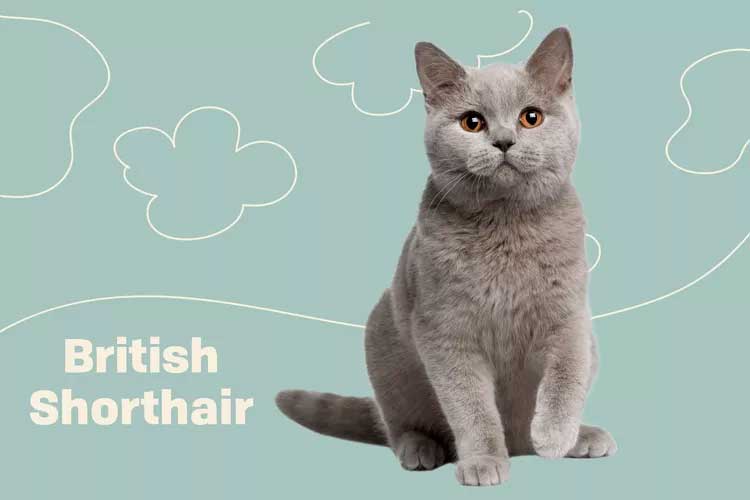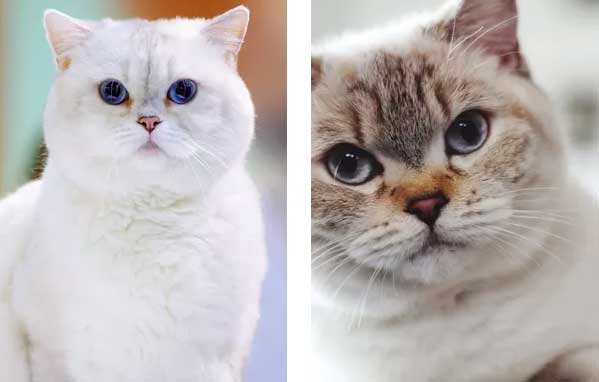British shorthair cats are one of the oldest recognized cat breeds, first thought to have been brought to Britain by the Romans. Prized for their soft, plush coats and rounded bodies, British shorthairs could almost be mistaken for living teddy bears.

British Shorthair Overview
| OFFICIAL NAME | British Shorthair |
| COMMON NAME | British Shorthair |
| PET HEIGHT | 12 to 14 inches |
| PET WEIGHT | 7 to 17 pounds |
| LIFESPAN | 15 to 20 years |
| GOOD WITH | cats, children, dogs, families, seniors |
| TEMPERAMENT | affectionate, sociable |
| INTELLIGENCE | high |
| SHEDDING AMOUNT | occasional |
| PLAYFULNESS | medium |
| ENERGY LEVEL | calm |
| VOCAL LEVEL | when necessary |
| COAT LENGTH | short |
| COLORS | black / ebony, blue / gray, chocolate / brown / sable, cinnamon, cream / beige / tan, fawn, lilac, red / orange, white |
| OTHER TRAITS | easy to groom, easy to train, friendly toward humans, friendly toward other pets, friendly toward strangers, good for first-time pet owners, high prey drive, strong loyalty tendencies, tolerates being alone |
One of the most popular cat breeds in the world, the British shorthair is appropriately named. Not only do they have a thick, plush short coat, they also have a friendly yet no-nonsense—that is, rather British—sensibility about life. British shorthairs make ideal family cats and enjoy being with their owners, but may turn up their noses at being held or cuddled too much.
This beautiful breed comes in a wide variety of colors and patterns, but the traditional British shorthair is wrapped in blue fur. The best part: This medium-to-large-sized cat has few health problems.
Appearance
Besides being treasured for their easygoing attitude about life, British shorthairs are beloved for their thick, dense coats that come in almost any color or pattern. Blue-gray cats, often called British blues, are probably the most popular color choice of British shorthair fanciers.But aside from their common blue coat, this breed is easy to recognize because of their thick legs, broad chests, rounded heads, and chubby cheeks that are totally pinchable. British shorthairs with blue coats have bold orange-amber eyes, but individuals with other coat colors can have green, copper, amber, or blue eyes.

These gorgeous cats only require a quick brushing once a week to keep their coat free of loose hair and dirt. British shorthairs are a large cat breed, with males potentially tipping the scales at 17 pounds.
Temperament
When it comes to temperament, British shorthairs are hard to beat: They're active without being boisterous, they're affectionate without being cloying, and they're smart but don't feel the need to show off by figuring out how to open your refrigerator. British shorthair cats are easygoing and will treat everyone in the family (including dogs and other cats) like a good friend, especially if socialized as kittens.
This happy breed loves a good romp as much as a night stretched out in front of the television. British shorthairs are ambiverts: They thrive on attention, but also value personal space and may turn up their noses at being held or hugged too much.
Marilyn Krieger, a certified cat behavior consultant in San Francisco, gives top marks to this cat breed. "They are sweet, laid back, and are loyal companions," she says.
Living Needs
Like most cats, British shorthairs aren't too fussy about where they live—as long as they have loving owners who take the time to interact with them. British shorthairs are a happy medium between playful and just wanting to snooze in the sun all day. This means he's always up for a game of chase-the-mouse-toy, but you won't have to worry about him getting into trouble while you're at work (especially if you give him plenty of toys for entertainment).
Because British shorthairs are a larger cat breed, make sure to buy at least two oversized litter pans to comfortably accommodate your pet when he's fully grown. A good rule to follow when choosing a litter box: It should be as wide as your cat is from his nose to the base of his tail and about half as long.
Like most cats, a British shorthair enjoys a cat tree (or two!) so he can scratch, stretch, and chatter at the window in comfort.
Care
Unlike long-haired cats, British shorthairs don't need to be fussed over to look good. Their short, soft, dense coat only requires weekly brushing to remove dead hair and skin cells. But for the most part, they do a good job keeping themselves clean and tidy.Like other breeds, British shorthairs need frequent nail trims and dental care, as well as regular trips to the veterinarian. Be sure to spay or neuter your pet and keep their vaccinations up to date, as instructed by your vet. Check their ears regularly for wax build-up or possible ear mites as well. It's also important to keep their litter boxes clean so they don't turn their nose up at it.
Health
British shorthairs are a large, healthy breed that can live up to 20 years. However, they are susceptible to certain health problems, as all breeds are.These kitties can be prone to a condition called hypertrophic cardiomyopathy, which is a thickening of the muscular walls of the cat's heart; this causes difficulty breathing, lethargy, and loss of appetite in older animals. And, similar to other breeds, British shorthairs can develop urinary tract and kidney issues.
To help prevent health problems from developing, start by getting your British shorthair kitten from a reputable breeder who uses healthy adults. And always take your cat to your vet once a year for a check-up.
In addition to regular health check-ups, exercise should play an important role in your British shorthair's life. These cats have energy but aren't that active, so they can gain too much weight (especially in their later years) unless you develop strategies that keep them moving when they're young. Interactive toys, fishing wands, balls, lasers, and climbing structures like cat trees and cat shelves will all help keep your British shorthair fit and trim, physically and mentally.
History
An ancient breed, British shorthairs are believed to be the direct descendants of the cats brought to England by the invading Romans, according to The Governing Council of the Cat Fancy. They were used for vermin control and quickly spread throughout the country as street and farm cats. Soon, their calm and confident personalities prompted people to welcome them into their homes (and onto their laps). Over the years, according to The Cat Fanciers' Association, they developed round faces with short, thick coats of all colors.In the late 1800s, a determined cat breeder named Harrison Weir began developing the British shorthair officially by crossing different individual felines. At the first organized cat show, held at London's Crystal Palace in 1871, a blue tabby British shorthair owned by Weir won Best in Show.
After World War I, the British shorthair we know today was finessed by adding Persian, Russian blue, French Chartreux, and domestic shorthair cats into the mix. Eventually, in the 1970s, the British shorthair was given formal recognition around the globe.
Fun Facts
British shorthairs have a special place in literature, too. Probably the most famous British shorthair is the Cheshire Cat in Alice's Adventures in Wonderland. No one really knows exactly where Lewis Carroll got his inspiration for the Cheshire Cat's smiling countenance—some believe it was from an illustration on a label of Cheshire Cheese; others believe he was inspired by a church sculpture. But whatever it was, the Cheshire Cat looks a lot like a contented British shorthair.With his chubby cheeks and big green eyes, Puss in Boots is generally considered to be a British shorthair (despite his Spanish accent).
Coby the Cat is a British shorthair with more than 1.5 million Instagram followers.